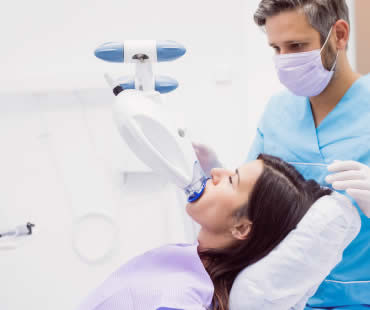
Jul 3, 2025 | Dental Topics 5, Teeth Whitening, Blog
Do you have a single tooth that has darkened due to trauma? The first step in determining if a damaged tooth can be lightened is to visit your dentist for a thorough examination.
Your dentist will need to identify what is causing the dark staining. To do this, your dentist may perform x-rays or other tests to learn if the pulp of the tooth is “vital” or alive. If the tooth is deemed to be alive, external bleaching may yield the whitening results you are seeking. Your dentist can create a single-tooth bleaching tray to whiten the traumatized tooth effectively. This type of tray keeps the bleach away from other teeth, producing the best color match for your overall smile.
However, if it is determined that the nerves have died and it is no longer a living tooth, your dentist may need to perform a root canal. Darkening of a dead tooth can happen immediately or may develop over time after a root canal procedure has been performed. For this type of tooth trauma, your dentist or endodontist may recommend bleaching the tooth from the inside.
Stains from a non-vital tooth come from the inside, rather than outside, of the tooth. Therefore, your dentist needs to put the bleach inside the tooth. This type of teeth whitening is a routine procedure that involves making a small opening in the tooth through which to bleach the tooth. Once this procedure is complete, you can assess with your dentist whether the desired results have been achieved. If the whitening is not enough, the tooth can then be bleached externally as well. If the results are still not acceptable, you may want to consider a tooth-colored veneer or crown.
If you have a darkened tooth marring your smile, consult your dentist to determine the best teeth whitening treatment to return your smile to its bright, white best.
Do not let another day go by without taking care of your dental needs. Request an appointment now at our Conyers dental office!

Jul 24, 2025 | Dental Topics 5, Teeth Whitening, Blog
By far, the best way to brighten and whiten your smile is through an in-office treatment performed by your dentist. The concentration of hydrogen peroxide in the whitening gel used by your dentist is much higher than that which can be obtained over-the-counter by you in a drugstore. Lasers or special lights are employed by many dentists to achieve the best results.
With the rise in popularity of in-office teeth whitening, some specialty brands have emerged that offer different methods and ingredient strengths to address even the most stubborn stains.
- BriteSmile also uses whitening gel and a blue light, but their gel has a concentration of 15 percent hydrogen peroxide and a nearly neutral pH level, a mix that is easier on sensitive gum tissue.
- Lumbrite employs a custom light, known as the Sapphire Plasma Arc Curing and Whitening Light. This light has no destructive UV rays, although the gel is so strong it can work without the light. Lumbrite also has a desensitizing agent in its gel to reduce problems with sensitivity.
- GLO Science Professional has a specialized mouthpiece that employs Guided Light Optics (GLO) that works in tangent with a whitening gel, delivering light and heat to the tooth surfaces. The mouthpiece prevents oxygen from leaving the treatment area, giving optimal whitening results.
- Philips Zoom! is one of the most popular and well-known of the teeth whitening brands available at the dentist’s office. Their whitening gel uses a 25 percent concentration of peroxide which is stimulated by a proprietary blue light to achieve maximum whitening and is said to provide a more sparkling look to your enamel.
- Opalescence uses one of the most powerful gels available, utilizing a 40 percent concentration of hydrogen peroxide as well as potassium nitrate to reduce gum and tooth sensitivity after treatment. It also contains fluoride which strengthens the tooth enamel and reduces decay.
Talk to your dentist today to determine which of these or any other professional whitening methods is best for you and your teeth whitening needs.
Take the first step towards optimal oral hygiene. Reserve your dental appointment at our Conyers dental office now and experience personalized care.

Sep 3, 2021 | Dental Topics 3, Teeth Whitening, Blog
Have you ever wondered if your smile could be brighter? Have you considered teeth whitening, but just aren’t sure if it’s appropriate for you? People are born with different shades of teeth, but over time, other factors can affect the color of the enamel. The color of your teeth may have changed due to the following:
- Pigment-rich food and beverages such as cola, wine, juice, berries, candy, and ketchup are just several examples of foods that may darken your teeth.
- Cigarette smoking and chewing tobacco are known to cause yellowing of teeth.
- Certain medications can result in tooth darkening. These offenders include some antibiotics, high blood pressures medicines, antipsychotic drugs and certain antihistamines.
- Chemotherapy or radiation treatments can cause teeth to change colors.
- Enamel wears away as you age, and teeth acquire a build-up of tartar and stains that darken your teeth.
- Excessive fluoride use either from your water, fluoride supplements, toothpaste or rinses can cause teeth to yellow.
- Trauma caused by a fall or blow to the mouth can damage nerves and cause teeth to permanently brown or blacken.
- Poor oral hygiene or avoiding regular dental care can cause teeth to turn unwelcome colors.
While some of these causes may make whitening more difficult, talk to a qualified dentist in Conyers about the best option for meeting your whitening goals. The general rule of thumb is for your teeth to closely match the shade of the whites of your eyes. Teeth that are too white will look unnatural, so if you choose professional whitening, you should consult with your dental professional about how to achieve the most natural result. In cooperation with your dentist, making the decision to undergo professional teeth whitening could mean you will soon be facing the world with a brighter, whiter smile.
We look forward to seeing you in our Conyers dental office

Mar 24, 2023 | Dental Topics 3, Teeth Whitening, Blog
Have you ever wondered if your smile could be brighter? Have you considered teeth whitening, but just aren’t sure if it’s appropriate for you? People are born with different shades of teeth, but over time, other factors can affect the color of the enamel. The color of your teeth may have changed due to the following:
- Pigment-rich food and beverages such as cola, wine, juice, berries, candy, and ketchup are just several examples of foods that may darken your teeth.
- Cigarette smoking and chewing tobacco are known to cause yellowing of teeth.
- Certain medications can result in tooth darkening. These offenders include some antibiotics, high blood pressures medicines, antipsychotic drugs and certain antihistamines.
- Chemotherapy or radiation treatments can cause teeth to change colors.
- Enamel wears away as you age, and teeth acquire a build-up of tartar and stains that darken your teeth.
- Excessive fluoride use either from your water, fluoride supplements, toothpaste or rinses can cause teeth to yellow.
- Trauma caused by a fall or blow to the mouth can damage nerves and cause teeth to permanently brown or blacken.
- Poor oral hygiene or avoiding regular dental care can cause teeth to turn unwelcome colors.
While some of these causes may make whitening more difficult, talk to a qualified dentist in Conyers about the best option for meeting your whitening goals. The general rule of thumb is for your teeth to closely match the shade of the whites of your eyes. Teeth that are too white will look unnatural, so if you choose professional whitening, you should consult with your dental professional about how to achieve the most natural result. In cooperation with your dentist, making the decision to undergo professional teeth whitening could mean you will soon be facing the world with a brighter, whiter smile.
If you live in the Conyers area contact us today

Nov 1, 2019 | Dental Topics 2, Teeth Whitening, Blog
There is no quicker or easier way to dramatically improve the look of your smile than professional teeth whitening. Your dentist probably offers several whitening options and can advise you about the most appropriate type of whitening treatment to ensure your brightest, whitest smile. No matter which whitening treatment you and your dentist decide will be best, there are several tips you can follow to help you achieve the ideal result:
- Have any existing dental problems treated prior to whitening to avoid side effects or complications.
- Schedule a professional teeth cleaning prior to your whitening appointment to remove buildup of plaque or tartar you cannot remove with home cleaning, and provide the best surface for the whitening treatment.
- Begin brushing with a desensitizing toothpaste several weeks before whitening to limit the sensitivity that can sometimes result from whitening agents.
- If you are extremely prone to dental sensitivity, check with your dentist about taking a painkilling medication before your whitening appointment.
- Consult with your dental office to determine how much time you should allow for your whitening appointment.
- Refrain from eating or drinking anything except water for at least one hour after the completion of your whitening treatment, and avoid ingesting foods and beverages that contain stain-causing agents for no less than 24 hours.
- Make sure to attend any follow-up appointments with your dentist.
- Maintain excellent home oral care habits to extend the life of your whitening procedure.
By following these tips, you can boost the results of your professional teeth whitening treatment and face the world with beautiful, bright smile!
If you live in the Conyers area contact us today

Jul 2, 2021 | Dental Topics 2, Teeth Whitening, Blog
Teeth whitening is the most popular cosmetic procedure that dentists perform today. It can have a dramatic effect on your smile at a smaller cost than other cosmetic procedures. You can whiten your teeth yourself using at-home techniques, but often professional whitening with your dentist’s help achieves the fastest and most effective results. Let’s examine the whitening options provided by most dentists to help you evaluate what might work for you.
Whitening at your dentist’s office:
The dentist applies a whitening product to your teeth containing higher percentages of hydrogen peroxide than what is available in at-home kits. Heat or light may be used also. This technique produces quick, uniform results, but it does sometimes cause temporary gum irritation or tooth sensitivity. This method is expensive, ranging between $500 to $1,200.
Home whitening supervised by your dentist:
A customized mouthpiece will be created by your dentist for you to fill at home with whitening gel, which contains a lower strength of hydrogen peroxide then the in-office gel. You wear the mouthpiece at home for several hours each day, and your dentist supervises the whitening with regular checkups. This method is convenient and less expensive at $300 to $500, but it produces slower results than in-office methods.
Repeating the process:
Whichever type of teeth whitening technique you might choose, remember that it isn’t a permanent repair to your teeth. You will need to repeat the process every year or two. The length of time between treatments will increase if you don’t smoke and avoid foods that are known to stain your teeth, such as coffee and red wine.
We treat patients from Conyers and the surrounding area





